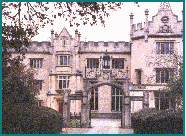
Llanderfel Church (Remains)

Location: Above the neighbourhood of Greenmeadow, at an altitude of approximately 1000ft above sea level on the Eastern slope of Mynydd Maen (Mountain of Stones) lay the remains of Llanderfel Church.
Within an adjacent field of Llanderfel Farm, the remains can be seen as a `L` shaped configuration . The section running East-West was the chapel. Next to the chapel was accommodation for the priest, and to the South a room which may have been used as accommodation for visiting pilgrims.
This `Celtic` Church, set in a semi-circular enclosure was dedicated to St.Derfel - 6th Century Saint and is one of only two, possibly three foundations( St.Dials - St.Derfel`s ? in Cwmbran ) of this Saint in all of Wales, the main church dedicated to him is at Llanderfel, Merionethshire (Gwynedd), North Wales.
* ST. Derfel`s Day - 5th April (Feast Day) *
Derfel,also known as `Derfel the Mighty` was the son of King Hoel II Fychan (the Small) and grandson of Heol I Mawr (the Great). His soldiering skills were celebrated in words and song by the bards of his day; and according to Welsh legend fought at the battle of Camlan in 542 A.D. where King Arthur was slain. Reputed to be one of only seven survivors, this experienced so traumatised him that he gave up his life of war and turned to religion. At first he became a hermit and spiritual advisor, then a monk at Llantwit and Abbot of Ynys Enlli at Bardsey, his final years may have been spent as a solitary at Llanderfel, the place founded by him, in the county of Gwynedd. He died of natural causes on the 6th April 660 A.D
* Llanderfel (Merionethshire) - a wooden figure of Derfel mounted on his horse was revered by the monks and a local prophecy foretold that it would take a `whole forest to burn` At the time of the Reformation during Henry V111`s reign, Derfel`s statue was taken from the church even though the local people offered �40 as a bribe, Thomas Cromwell`s agent for the Diocese of St. Asaph requested guidance and he was then ordered to send the statue to London. On the 22nd of May, 1538 at Smithfield, London, the statue was burnt on the pyre of the Franciscan friar John Forest, from Greenwich, who was Queen Catherine's Confessor. Thus the old Welsh prophecy that the statue would one day "set a whole forest on fire" was unfortunately fulfilled.
* It is also believed there was a statue to St. Derfel at Llanderfel, Gwent.

.. for more info ..
Llantarnam Abbey dates back to 1179 and was founded by monks of the Cistercian Order who travelled from the Strata Florida Abbey (Pontrhydfendigaid, Cardiganshire), in 1164. The land was given to them by Hywel ap Iorwerth, Lord of Caerleon; within the boundaries of this land lay Llanderfel. Because Llanderfel was held in such veneration, local pilgrimages were common and in the Valor Ecclesticus of 1535, a sum of �1.68 per annum in offerings was recorded. Three years later the Monastery, like many others throughout Wales and England was `Dissolved` due to the Reformation by Henry V111.
The Cistercians ... who were they?
A Monastic Order founded in 1098 - Throughout Europe they developed a network of monasteries and farms and within Wales they promoted and embraced the Welsh culture.
CISTERCIAN WAY
Webmaster:- 17th October 2004, I walked with a group of people, led by Dr. Madeleine Gray (History lecturer at the University of Wales College, Newport) to Llanderfel church, we followed an ancient walkway that pilgrims would have used. At the time of the Cistercians, sick pilgrims were carried by friends and family along well trodden pathways to these places of sanctuary, for help and spiritual guidance. The walkway will form part of a 650 mile Pilgrims route around Wales linking many ancient sites.
Along the proposed route walkers will also encounter Stone Age burial mounds, Abbeys, Medieval castles, scenic views and spectacular coastline, etc.